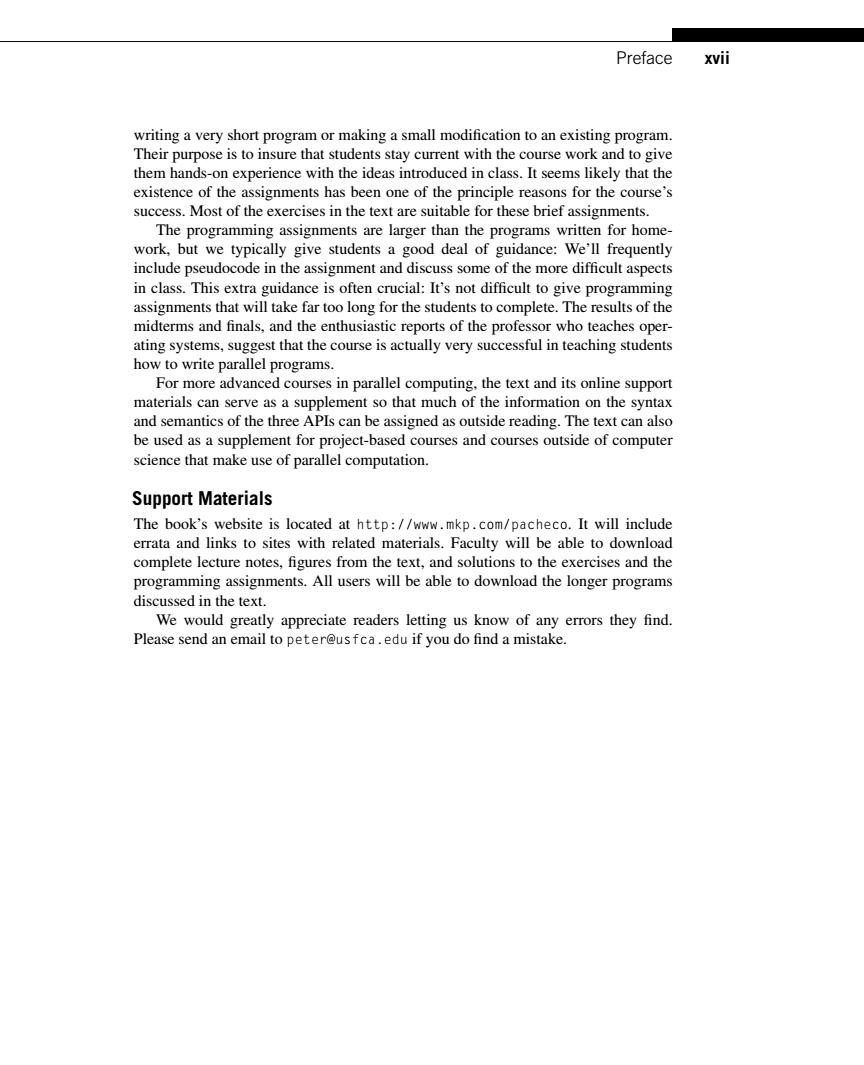正在加载图片...

Preface xvii writing a very short program or making a small modification to an existing program. Their purpose is to insure that students stay current with the course work and to give them hands-on experience with the ideas introduced in class.It seems likely that the existence of the assignments has been one of the principle reasons for the course's success.Most of the exercises in the text are suitable for these brief assignments. The programming assignments are larger than the programs written for home- work,but we typically give students a good deal of guidance:We'll frequently include pseudocode in the assignment and discuss some of the more difficult aspects in class.This extra guidance is often crucial:It's not difficult to give programming assignments that will take far too long for the students to complete.The results of the midterms and finals,and the enthusiastic reports of the professor who teaches oper- ating systems,suggest that the course is actually very successful in teaching students how to write parallel programs. For more advanced courses in parallel computing,the text and its online support materials can serve as a supplement so that much of the information on the syntax and semantics of the three APIs can be assigned as outside reading.The text can also be used as a supplement for project-based courses and courses outside of computer science that make use of parallel computation. Support Materials The book's website is located at http://www.mkp.com/pacheco.It will include errata and links to sites with related materials.Faculty will be able to download complete lecture notes,figures from the text,and solutions to the exercises and the programming assignments.All users will be able to download the longer programs discussed in the text. We would greatly appreciate readers letting us know of any errors they find. Please send an email to peter@usfca.edu if you do find a mistake.Preface xvii writing a very short program or making a small modification to an existing program. Their purpose is to insure that students stay current with the course work and to give them hands-on experience with the ideas introduced in class. It seems likely that the existence of the assignments has been one of the principle reasons for the course’s success. Most of the exercises in the text are suitable for these brief assignments. The programming assignments are larger than the programs written for homework, but we typically give students a good deal of guidance: We’ll frequently include pseudocode in the assignment and discuss some of the more difficult aspects in class. This extra guidance is often crucial: It’s not difficult to give programming assignments that will take far too long for the students to complete. The results of the midterms and finals, and the enthusiastic reports of the professor who teaches operating systems, suggest that the course is actually very successful in teaching students how to write parallel programs. For more advanced courses in parallel computing, the text and its online support materials can serve as a supplement so that much of the information on the syntax and semantics of the three APIs can be assigned as outside reading. The text can also be used as a supplement for project-based courses and courses outside of computer science that make use of parallel computation. Support Materials The book’s website is located at http://www.mkp.com/pacheco. It will include errata and links to sites with related materials. Faculty will be able to download complete lecture notes, figures from the text, and solutions to the exercises and the programming assignments. All users will be able to download the longer programs discussed in the text. We would greatly appreciate readers letting us know of any errors they find. Please send an email to peter@usfca.edu if you do find a mistake